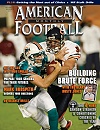Article CategoriesAFM Magazine
|
Speed Report: Football Coach or Football Speed Coach –You Can Be Bothby: Dale BaskettFootball Speed Specialist © More from this issue You don’t have to be apprehensive when you think about football speed development. You don’t have to feel incompetent when it comes to developing team speed. That is, if you have a certain knowledge of the subject of football speed. If you don’t, you might feel uneasy about teaching it. My quest in this article is to provide you with perspective about football speed and how you can feel more comfortable with what it takes to do it right – right according to the scientific knowledge that’s available. As I go from high school to high school, college to college, and even the pros, I’m always amazed at the fact that everyone I work with is using the same methods. It’s not their fault. They have to deal with what’s available for them in the marketplace of programs for football speed. Unfortunately they do....The full article can only be seen by subscribers.
|
|
|||||||
| HOME |
MAGAZINE |
SUBSCRIBE | ONLINE COLUMNISTS | COACHING VIDEOS |
Copyright 2025, AmericanFootballMonthly.com
All Rights Reserved





